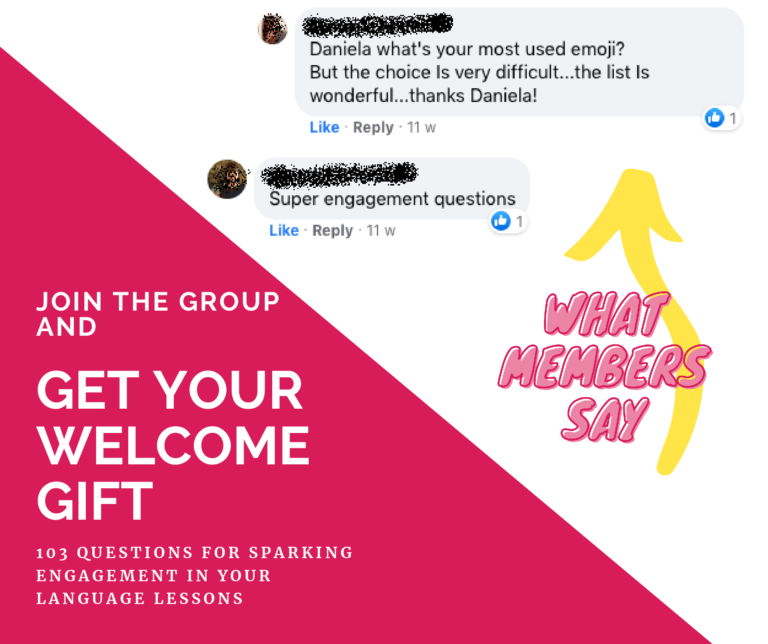
There are thousands of resources out there claiming to give you the magic formula “How to plan a lesson”. Most of them gives very good and reliable tools, indeed. I can’t avoid the subject in this blog, which is all about language teaching and sustainable learning. Regardless of the pattern you want to use for designing a language lesson plan, in this post I’d like to point your attention towards the key elements that truly promote maximum personalisation, even in the case you teach groups of students and it may seem to you that personalisation is a mission impossible!
Here are the key questions I’m going to answer:
- How can you plan a lesson for language learners?
- Which elements should you pay extra attention to?
- How to plan a lesson for personalising the learning experience?
- What to do with challenging students?
The basics: how to plan a lesson for language learners
The process for getting clear on how to plan a lesson for the language classroom is the following one:
- Bear in mind the type of students the lesson is for (age, level, etc.)
- Bear in mind the time: lesson length
- Set the acquisition goals: the vocabulary they’ll need to absorb, the grammar structures they’ll need to practice, the communicative functions
- Get specific about the 4 basic language skills (speaking, writing, reading, listening) and what the students are expected to do, for instance: speaking by following structured scripts, writing short sentences for describing their family, etc.
- Decide on how to balance the phases belonging to the acquisition unit: is the lesson going to cover only one phase of the acquisition unit (for instance, the globality phase), or is it going to cover globality-analysis-synthesis phases?
- Decide on the overall type of approach: will it be a formal, academic lesson rather than interactive or playful one? In my view, you don’t have to decide on the methods at this stage because that is something you are going to decide on in the next phase
- Set the assessment method: how will you know the lesson has been effective? What will you be focussing your attention on? Which behaviours would you like to observe in the students?
- Homework: what assignments are you planning to give your students? Will they need to follow up on the lesson?
- Design the detailed lesson plan
- List the resources and materials you need for delivering the lesson
Plan what you foresee: which elements should you pay extra attention to?
When you put down the acquisition goals and the expected results (scores 3, 4 and 7 of the process above), don’t do it as it was an exercise of style. You ought to pay extra attention to those 3 scores because they are the true core of your lesson. My suggestion is to really think about the take-aways for your students. Here are some trigger questions that can help you to get clear on this:
- What do I want the students to walk away with at the end of the lesson?
- What objective behaviours (i.e. behaviours you can observe with your eyes and words the students will be speaking) do I want to see at the end of the lesson or during the lesson?
- If I had to choose only three results (take-aways) for my students, what would I pick?
- And what would I pick if I had to choose only one take-away?
That’s what I mean by setting priorities. Remember: a good lesson plan gives you guidelines for acting in the classroom. True. Also, those trigger questions give you clarity on how to stay focussed, still, firm and relaxed whether the lesson flows smoothly or you come across objections to overcome. Sailors on a ship may lose their cool and focus. The captain is not allowed to do the same.
How to plan a lesson for personalising the learning experience – even within groups
Is what I wrote above still true and applicable in case you teach groups of students? Many of us, language teachers, teach groups of students. Big groups, very often. My answer is: yes, totally. Especially if you teach groups, you really should ask yourself those questions and get clear on your expectations in terms of observable behaviours. Also, coming up with three take-aways and then only one, big take-away will actually help you to avoid distractions.
In (big) groups you will need that to observe how the students behave and how they are getting closer to the expected results.
What to do with challenging students?
A plan is a plan, therefore it ought to include a few details on exceptions and specific situations YOU KNOW you’ll be facing. For instance, you may already know some students won’t be getting closer to the expected results. Then, define what take-aways you want for them. Tweak the expected results and be specific about the take-aways you want for each challenging student.
Wrapping up
My goal wasn’t actually to explain how to plan a lesson in detail. On the contrary, I wanted to explore a challenging matter: how to plan a lesson for personalising the learning experience, for promoting sustainable learning that makes the difference to each of your students. In my view, this means planning to win, both for our students and for us.
Want more support?
Join the Facebook group Independent Language Teachers Collective to get daily advice, tons of free training and to branch out with other independent language teachers like you!
ALSO…
Available only for the Collective members: free list 103 question for sparking engagement in your language lessons.
This is what members say about the freebie:

Join in the Collective and grab your welcome gift:


